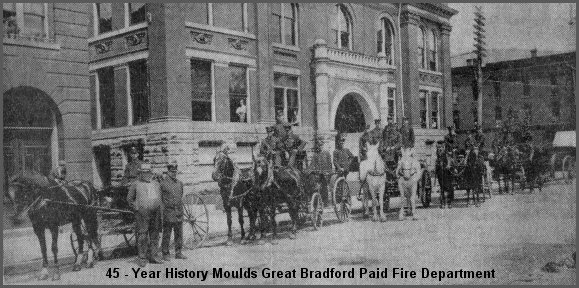Bradford Fire Department
 Here is a family portrait of the Bradford Fire Department taken in front of the City Hall during the first Old-Home Week in
1909, three years before the first motorized equipment began to replace the more colorful, exciting horse-drawn equipment. The horses held sway
nine years after the paid-department was organized. In the nostalgic array of fire-fighting equipment, left to right, are the
chief's rig, Hose Companies no.1 and 2. East Bradford Hose Company, and thehHook and
ladder Company. Standing beside the chief's rig are the late mayor R.J. Hoffman (in straw hat)
and chief Charles henderson. The present chief \, Edward larkin, is the third man (left to right) standing on the fire buggy with the white horses.
Here is a family portrait of the Bradford Fire Department taken in front of the City Hall during the first Old-Home Week in
1909, three years before the first motorized equipment began to replace the more colorful, exciting horse-drawn equipment. The horses held sway
nine years after the paid-department was organized. In the nostalgic array of fire-fighting equipment, left to right, are the
chief's rig, Hose Companies no.1 and 2. East Bradford Hose Company, and thehHook and
ladder Company. Standing beside the chief's rig are the late mayor R.J. Hoffman (in straw hat)
and chief Charles henderson. The present chief \, Edward larkin, is the third man (left to right) standing on the fire buggy with the white horses.

By Edward Hogan
Breathes there a man with soul so dead who never to himself has said many times that his heart has skipped a beat or two as he hurried to the curb with the approaching clang and scream of the fire bells and sirens and then with chills racing up and down his spine in tempo with the bells, stands
frozen to the spot as the red engines flash by on their mission of mercy and protection.
This is perhaps a frequent occurence in most American communities and one that always thrills every person from six to 60, no matter how cynical or naive, he may pretend to be - one that always alerts his latent urge for excitment.
The zest for watching and chasing fire engines has not died since the hell-foe-leather days of the old volunteers down tothe motorized, paid departments of today.
Memories of those early volunteer days were revived recently as Chief Edward larkin, verteran membeer of the Bradford Fire Department, took this writer ona personally conducted tour of the exempt Firedepartment's room.
Housed in this room on the second floor of the Central Fire Station, are an array of priceless trophies, volunteer firemen's convention medals, pictures of horse drawn equipment, early mayors of the city, and a multitude of other fire-fighting museum pieces.
Gracing the walls, too, are the bewhiskered volunteers held in high esteem by the hero worshiping kids of the gay 90's and thurn of the century in this city.
As our minds wandered back to those fabulous era, the horses seemed to leap from the walls and flash by, their flying hooves stricking off a cluster of sparks on the cobblestone pavement as they galloped t a distant rred glow against the night sky, their drivers having left behind a bewildered half-shven gentleman or a customer standing int he act of buying
groceries or a pair of shoes.
With a wistful look in his eyes, Chief Larkin's thoughts went back to April, 1903 the year and month that Bradford broke away from the days of the old volunteer firefighters and formed the more efficient, disciplined paid department during the tenure of the late Mayor
George H. Potter.
Chief Larkin, now 65, and fifth chief of the city's modern fire-fighting brigade said that Chief J. Flick was the first chief of the paid department. "Mr. Flick, a mail carrier, took a leave of absence from the post office to organize the department. However, after three months, he returned to the post office.
The first department was set up along a semi-military pattern, the chief explained, with a chief, minute men, regular men and a cadets. I began my smoke-eating career as a minute man in May of 1903
We had 25 men in the first department who were on duty 24 hours a day with one day a month off. The average salary was $50 monthly. Today we have a crew of 22 men who work 10 hours onthe day shift and 14 hours on the night shift with a day off each week.
After three months William TOY took over the reins of the department for a two-year term. He was followed by Burt McAllister, who served three years. McAllister was succeeded by Charles Henderson who was chief for 20 years. Chief Larkin, the man who rose from the ranks, became chief on Jan. 3, 1928. He is now in his 35th year as a member of the department and his 20th year as its head.
Before the fire Department was put under one roof at Central Station in 1910 and became motorized in 1912, the four horse drawn units were housed in Pine St., site of the present American Legion Post; Barbour St., site of the former TruTred Co.; Kennedy St., site of the Downs furniture store; and at the present site of the East Bradford Station.
Today, Bradford has one of the most efficient, and best-equipped fire departments in the state as attested by the low insurance rates and the fact that the fire-fighters have nipped many a potential major fire in the bud.
Pictures and text contributed by Sheila Barr Helser
Items were saved by her grandmother Margaret TOY BARR
|

